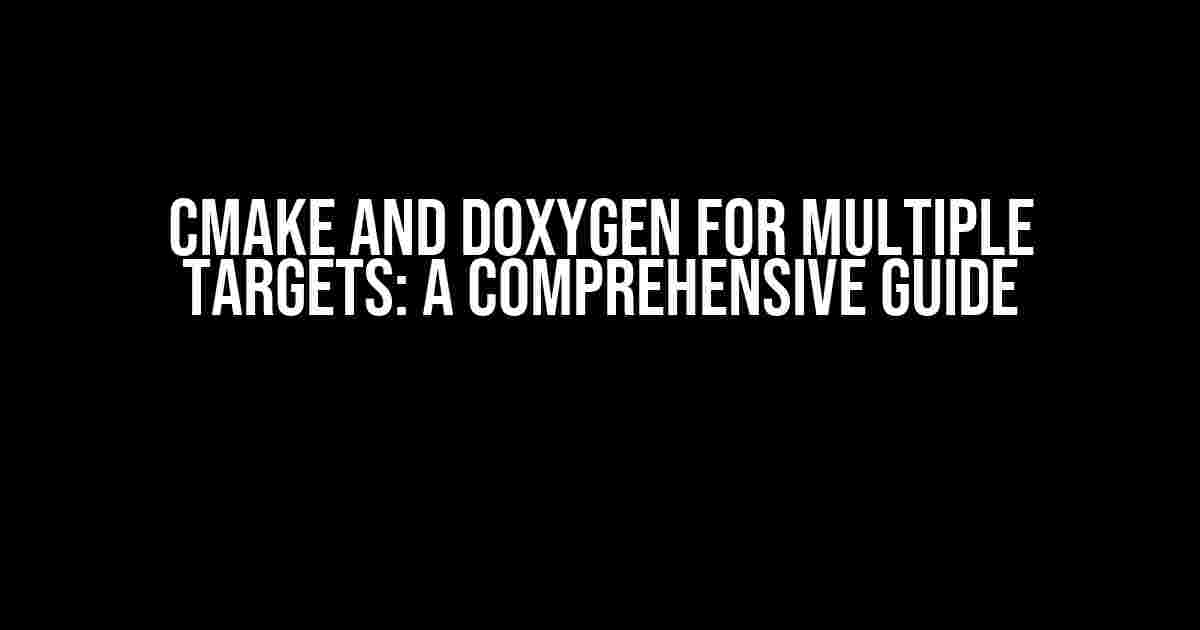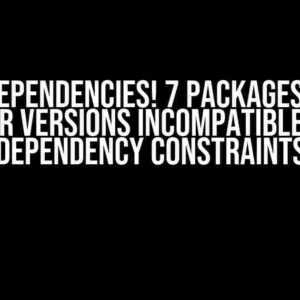Are you tired of juggling multiple projects and struggling to generate documentation for each one? Look no further! In this article, we’ll explore the powerful combination of CMake and Doxygen to streamline your development process and create stunning documentation for multiple targets.
What is CMake?
CMake is an open-source, cross-platform build system generator. It’s a powerful tool that enables developers to create platform-independent build systems for their projects. With CMake, you can generate build files for various platforms, including Windows, macOS, and Linux.
Why Use CMake?
- Platform independence: CMake allows you to generate build files that can be used on multiple platforms.
- Flexible configuration: CMake provides a flexible and customizable way to configure your build process.
- Easy integration: CMake integrates well with various development environments and tools.
What is Doxygen?
Doxygen is a free, open-source documentation generator. It’s a powerful tool that enables developers to generate documentation for their source code. With Doxygen, you can create high-quality documentation in various formats, including HTML, PDF, and LaTeX.
Why Use Doxygen?
- Automatic documentation: Doxygen can automatically extract information from your source code and generate documentation.
- Customizable output: Doxygen provides a range of customization options to tailor the output to your needs.
- Multi-language support: Doxygen supports documentation generation for multiple programming languages.
CMake and Doxygen for Multiple Targets
Now that we’ve introduced CMake and Doxygen, let’s explore how to use them together to generate documentation for multiple targets.
Step 1: Create a CMakeLists.txt File
Create a new file called CMakeLists.txt in the root directory of your project. This file will contain the configuration for your CMake build system.
cmake_minimum_required(VERSION 3.10) project(MyProject) set(CMAKE_CXX_STANDARD 14) set(CMAKE_CXX_STANDARD_REQUIRED ON) add_executable(MyExecutable main.cpp) add_library(MyLibrary library.cpp)
Step 2: Configure Doxygen
Create a new file called Doxyfile.in in the root directory of your project. This file will contain the configuration for your Doxygen documentation generator.
DOXYGEN_PROJECT_NAME = MyProject DOXYGEN_OUTPUT_DIRECTORY = doc DOXYGEN InputFiles = @CMAKE_CURRENT_SOURCE_DIR@/main.cpp @CMAKE_CURRENT_SOURCE_DIR@/library.cpp
Step 3: Integrate CMake and Doxygen
Modify your CMakeLists.txt file to integrate Doxygen and generate documentation for multiple targets.
cmake_minimum_required(VERSION 3.10)
project(MyProject)
set(CMAKE_CXX_STANDARD 14)
set(CMAKE_CXX_STANDARD_REQUIRED ON)
add_executable(MyExecutable main.cpp)
add_library(MyLibrary library.cpp)
find_package(Doxygen REQUIRED)
configure_file(${CMAKE_CURRENT_SOURCE_DIR}/Doxyfile.in ${CMAKE_CURRENT_BINARY_DIR}/Doxyfile @ONLY)
add_custom_target(doc ALL
COMMAND ${DOXYGEN_EXECUTABLE} ${CMAKE_CURRENT_BINARY_DIR}/Doxyfile
WORKING_DIRECTORY ${CMAKE_CURRENT_BINARY_DIR}/doc
)
add_dependencies(MyExecutable doc)
add_dependencies(MyLibrary doc)
Step 4: Generate Documentation
Run the following command to generate the documentation for your multiple targets:
cmake .. cmake --build . cmake --build . --target doc
This will generate documentation for both the MyExecutable and MyLibrary targets.
Customizing Doxygen Output
Doxygen provides a range of customization options to tailor the output to your needs. Here are a few examples:
Customizing the Output Directory
DOXYGEN_OUTPUT_DIRECTORY = doc/${PROJECT_NAME}
Customizing the Documentation Format
DOXYGEN_GENERATE_HTML = YES DOXYGEN_GENERATE_LATEX = NO
Customizing the Documentation Layout
DOXYGEN_RECURSIVE = YES DOXYGEN_EXCLUDE_PATTERNS = */internal/*
Tutorial: Creating a Multi-Target Project
Let’s create a simple multi-target project using CMake and Doxygen.
Step 1: Create a New Project Directory
Create a new directory for your project, and create the following subdirectories:
- src: This will contain your source code.
- doc: This will contain your generated documentation.
Step 2: Create Source Code Files
Create two new files in the src directory: main.cpp and library.cpp.
// main.cpp
#include <iostream>
int main() {
std::cout << "Hello, World!" << std::endl;
return 0;
}
// library.cpp
#include <iostream>
void printMessage() {
std::cout << "Hello from the library!" << std::endl;
}
Step 3: Create a CMakeLists.txt File
Create a new file called CMakeLists.txt in the root directory of your project.
cmake_minimum_required(VERSION 3.10)
project(MyMultiTargetProject)
set(CMAKE_CXX_STANDARD 14)
set(CMAKE_CXX_STANDARD_REQUIRED ON)
add_executable(MyExecutable src/main.cpp)
add_library(MyLibrary src/library.cpp)
find_package(Doxygen REQUIRED)
configure_file(${CMAKE_CURRENT_SOURCE_DIR}/Doxyfile.in ${CMAKE_CURRENT_BINARY_DIR}/Doxyfile @ONLY)
add_custom_target(doc ALL
COMMAND ${DOXYGEN_EXECUTABLE} ${CMAKE_CURRENT_BINARY_DIR}/Doxyfile
WORKING_DIRECTORY ${CMAKE_CURRENT_BINARY_DIR}/doc
)
add_dependencies(MyExecutable doc)
add_dependencies(MyLibrary doc)
Step 4: Create a Doxyfile.in File
Create a new file called Doxyfile.in in the root directory of your project.
DOXYGEN_PROJECT_NAME = MyMultiTargetProject
DOXYGEN_OUTPUT_DIRECTORY = doc/${PROJECT_NAME}
DOXYGEN_InputFiles = @CMAKE_CURRENT_SOURCE_DIR@/src/main.cpp @CMAKE_CURRENT_SOURCE_DIR@/src/library.cpp
Step 5: Generate Documentation
Run the following command to generate the documentation for your multi-target project:
cmake .. cmake --build . cmake --build . --target doc
This will generate documentation for both the MyExecutable and MyLibrary targets.
Conclusion
In this article, we’ve explored the powerful combination of CMake and Doxygen to streamline your development process and create stunning documentation for multiple targets. With these tools, you can generate high-quality documentation with ease and focus on what matters most – developing amazing software.
By following the steps outlined in this article, you can create a robust and flexible build system that integrates seamlessly with Doxygen. Whether you’re working on a small project or a large-scale enterprise application, CMake and Doxygen are the perfect tools to help you succeed.
Further Reading
If you’re interested in learning more about CMake and Doxygen, here are some additional resources to explore:
- CMake documentation: https://cmake.org/documentation/
- Doxygen documentation: https://www.doxygen.nl/manual/docblocks.html
- CMake and Doxygen tutorials: https://cmake.org/cmake/help/latest/tutorial.html
Happy coding!
Frequently Asked Questions
Get the most out of CMake and Doxygen for multiple targets with these FAQs!
How do I configure CMake to generate multiple targets, such as libraries and executables?
You can use the `add_library()` and `add_executable()` commands in your CMakeLists.txt file to define multiple targets. For example, you can create a library target with `add_library(mylib ${MYLIB_SOURCES})` and an executable target with `add_executable(myexe ${MYEXE_SOURCES})`. You can also use the `target_link_libraries()` command to link the library to the executable.
Can I use Doxygen to generate documentation for multiple targets in a single project?
Yes, you can use Doxygen to generate documentation for multiple targets in a single project. You can use the `INPUT` and `FILE_PATTERNS` tags in your Doxyfile to specify the files and directories that you want to include in the documentation. For example, you can use `INPUT = ./library ./executable` to include files from both the library and executable directories.
How do I customize the output of Doxygen for each target in my project?
You can customize the output of Doxygen for each target by using the `OUTPUT_DIRECTORY` tag in your Doxyfile. For example, you can use `OUTPUT_DIRECTORY = ./library/doc` to generate documentation for the library target in a separate directory. You can also use the `HTML_OUTPUT` and `LATEX_OUTPUT` tags to customize the output format and directory for each target.
Can I use CMake to automate the generation of Doxygen documentation for multiple targets?
Yes, you can use CMake to automate the generation of Doxygen documentation for multiple targets. You can use the `find_package(Doxygen)` command to locate the Doxygen executable and then use the `add_custom_target()` command to generate the documentation for each target. For example, you can use `add_custom_target(doc_library COMMAND ${DOXYGEN_EXECUTABLE} Doxyfile_library)` to generate documentation for the library target.
How do I integrate the Doxygen documentation with my CMake build system?
You can integrate the Doxygen documentation with your CMake build system by adding a custom target that depends on the Doxygen documentation. For example, you can use `add_custom_target(doc ALL COMMAND ${DOXYGEN_EXECUTABLE} Doxyfile)` to generate the documentation as part of the build process. You can also use the `add_dependencies()` command to specify that the documentation target depends on the library and executable targets.




